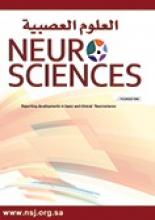Abstract
OBJECTIVE: To evaluate the role of different neurophysiological tests in the differential diagnosis of diabetic axonal neuropathy (DAN) and lumbosacral radiculopathy (LSR).
METHODS: This study was conducted at Al-Kadhimiya Teaching Hospital, Baghdad, Iraq, from July 2006 to February 2007. Twenty-seven healthy subjects, 44 type 2 diabetics, and 36 LSR patients were studied. The HbA1c level, plain x-ray, and MRI of the lumbosacral region and different electrophysiological tests were assessed.
RESULTS: The sural sensory nerve action potential(SNAP) amplitude values were reduced in 56.3%, and the sural/radial amplitude ratio (SRAR) values were reduced in 71.8% in the diabetic patients, but not in the LSR group. The peroneal compound muscle action potential (CMAP) amplitude was low in 70.45% DAN patients versus 35.5% LSR patients. Peroneal F-minimum (Fmin) values were prolonged in 56.8% DAN versus 32.25% LSR patients. The Fpersistence(Fp) values were low in 72.7% of DAN, versus 45.2% of LSR patients. However, the Fchronodispersion(Fc) was abnormal in 71% of LSR versus 11.4% of DAN patients.
CONCLUSION: The SRAR was found to be more significant than the sural SNAP amplitude alone in the differential diagnosis of the 2 groups. Abnormal peroneal Fc and Fp seems to be valuable tests in the detection of LSR and DAN patients.
- Copyright: © Neurosciences
Neurosciences is an Open Access journal and articles published are distributed under the terms of the Creative Commons Attribution-NonCommercial License (CC BY-NC). Readers may copy, distribute, and display the work for non-commercial purposes with the proper citation of the original work.






